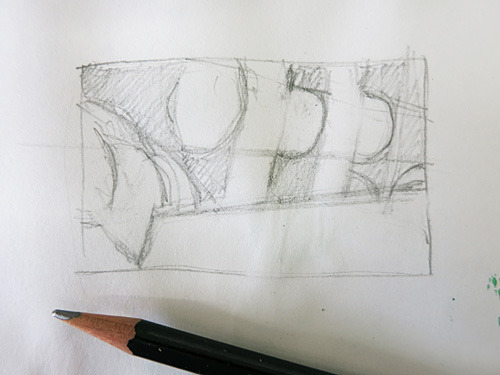Exploring Michel's Garden

Le jardin de Michel, watercolor and ink on Arches hot press, 13"x 8"
My friend Michel asked me to do an illustration of his garden for his birthday, which was on Saturday. Little did I know what I was getting into! The image above is the first one I attempted. This is more or less what I planned to do, showing what was really growing and blooming. It took a long time to draw all those ivy leaves, but they form so much of the backdrop and frame for the garden, I couldn't leave them out!
But I didn't feel finished with the subject yet. One morning I went back and sketched the garden again, trying to find its underlying rhythm.
While I was there, sitting on the median strip between the bike path and the street, a young man came along on his bike and stopped to watch. I was concentrating and didn't look up for a while; then he spoke to me, and we began chatting. It turned out that he is an artist himself, a comic-book/graphic novel artist who's doing a project where he interviews and draws Montrealers he finds doing interesting things on the streets. He asked if he could interview me, and I said sure, so we talked. That was fun, and unexpected.
But I kept wanting to do something more abstract too. I did some small sketches like the one below to try to figure out the essential shapes and forms making up the composition, and how I might alter them.
I did a couple of failed paintings, of which you saw a fragment.
Springboarding from these latter two, over the weekend I did a much more abstract watercolor sketch. It's not much of a painting, but reducing the scene to its essential elements was a very productive exercise. It captures more of the energy of the lively hanging baskets and emphasizes the baskets and the tall vertical towers of runner beans, without getting caught up in details, which is so easy to do when looking at a garden. What I don't like here is the color -- I'm not fond of red and green together, and adding the yellow made it even less pleasing!
So today I decided to go back to black and white -- always better for me when I'm trying to look at structure -- and did this charcoal sketch, from an angle rather than straight on.
Interesting. The color really isn't important, and previously I think it complicated things, making an already busy scene even busier. I'm particularly interested in what we see when we look at a garden, or a larger landscape filled with plants. Most people would probably answer "color," but I think I respond more to form, and then to form-within-form: the garden's shape itself, the structures and repetions within it; shapes of individual plants, the shapes of leaves.
Like sculpture, which they are, it helps to see gardens in three dimensions. As soon as we move into 2 things get harder - which is why photographs of gardens rarely manage to convey the sense of being there. But an artist can choose what to emphasize. This sketch finally begins to approach what Michel did so well in designing his garden: leading the eye across and upward, while the repetitive element of the softly rounded hanging baskets forms a linking structure across the whole scene.
---
I couldn't sleep in the middle of last night, and I got up and studied the catalogue from last summer's "Van Gogh Up Close" exhibition in Ottawa. He was preoccupied with the same problem in many of his landscapes and garden pictures: how to move beyond the particular without ever relinquishing his love for, and great awareness of, that particular: for each single blade of grass, as he put it, and without creating works that are conventionally "pretty" or overly sweet. His work, with its all-over attention to structure and detail, rendered in various types of shorthand mark-making, are always built on attention to shape and form, even though we often think of their color first.
Cottage Garden,Vincent Van Gogh. Reed pen, quill, and ink drawing over graphite, 1888.
When that color is taken away, in his drawings, often done in sepia with a flat-nibbed pen, you can see how he was approaching the compositions, integrating a great deal into one unified whole, with a surface flatness that reflects his great interest in Japanese prints. There are no washes here, just larger and smaller marks, all very directional and consciously shaped. When I first saw his drawings, many decades ago, I didn't appreciate them. Now I find them very moving. Van Gogh was able to see the complex interlocking structure formed by plants, and to reduce it into an abstract texture of form and movement that, to me, resembles music.
It was hugely helpful to me to revisit these works, and I shut the book last night with a sense of profound gratitude and connection with this sensitive, suffering genius.
"In spite of everything I shall rise again:
I will take up my pencil, which I have forsaken
in my great discouragement, and I will go on
with my drawing."
Vincent van Gogh
24 September 1880









